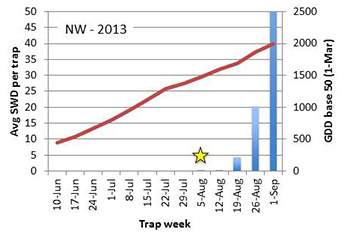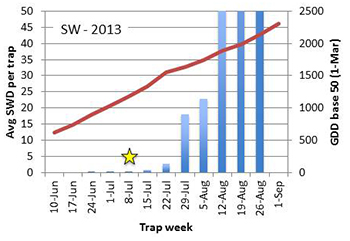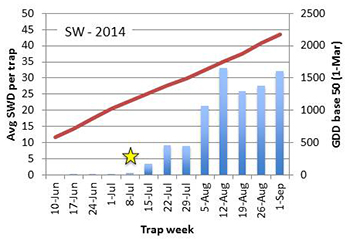Michigan spotted wing Drosophila 2014 summary report
A look at what season-long patterns in 2014 compared with 2013 tell us about spotted wing Drosophila in Michigan fruit crops.

Spotted wing Drosophila (SWD), Drosophila suzukii, is an invasive pest first detected in Michigan in late 2010. It is a small, vinegar fly that can lay eggs under the skin of intact thin-skinned fruit. SWD females will attack a variety of wild and cultivated fruit-bearing plants, including cultivated red raspberries, blackberries, strawberries, blueberries, cherries, wild brambles, honeysuckle and other wild, fruit-bearing shrubs and trees. Given a choice among cultivated fruit, SWD prefer red raspberry and strawberry over blueberry and cherry fruit, but all of these crops are susceptible during ripening and must be protected if fertile SWD females are detected in monitoring traps.
About the SWD monitoring network
To track statewide incidence of SWD in Michigan fruit production areas, a weekly SWD statewide monitoring network was set up from the beginning of June through the end of August. Traps were placed at the edge of susceptible crops or in hedgerows containing wild fruit-bearing shrubs and trees, and monitored by Michigan State University Extension educators, researchers and consultants. Catches throughout the state were reported weekly through MSU Extension Fruit & Nuts News. Our network of traps across more than 100 sites extended into the following counties: Berrien, Van Buren, Allegan, Kalamazoo, Kent, Ionia, Montcalm, Oceana, Muskegon, Antrim, Leelanau, Grand Traverse, Benzie, Ingham, Genesee, Livingston and Oakland.
Evaluating user-friendly traps
One of our goals this year was to evaluate the efficacy of traps baited with a commercial dry lure compared with the apple cider vinegar or yeast-sugar baited traps we had used in previous seasons. Initial monitoring efforts in 2011 relied on a homemade trap baited with apple cider vinegar. In 2012 and 2013, we found that the same trap baited with a yeast and sugar solution captured flies earlier and in greater numbers than the apple cider vinegar-baited trap. However, the yeast and sugar bait made checking traps and identification of flies difficult.
In 2014, we tested a newly developed dry lure suspended over soapy water. The dry lure traps were substantially more user-friendly and in general they have trapped SWD at about the same time, though with lower catches in some cases. Full analysis of the 2014 data is ongoing and we will be presenting results at the upcoming winter Extension meetings.
Comparison of 2013 and 2014 trapping results, and relation to fruit harvest timing
Monitoring results indicated that while SWD average trap catches were lower in 2014 than in 2013, the beginning of the mid-summer increase in SWD adults occurred within the same week in each year – July 8 in the southwest and Aug. 5 in the northwest. This is despite the fact that growing degree days (GDD) accumulated at a slower rate in 2014 and that harvest began later for some susceptible crops.
- June bearing strawberries seemed to escape the early activity of SWD, though we have found larger infestations in the ever-bearing fruit later this season.
- Cherries were at greater risk of becoming infested by SWD in 2014 than in 2013 because of a delayed harvest overlapping with the mid-summer increase in SWD activity.
- Increasing SWD activity coincided with the middle of blueberry harvest, resulting in greater pest pressure from SWD for later ripening berries. This is the same pattern we have seen in blueberries over the past three seasons, and growers have adapted their pest management programs to focus attention on fields of the later-harvested cultivars.
- For summer raspberries, harvest was mostly finished before this pest increased in abundance. In contrast, fall-bearing raspberries continue to be most at risk due to their high susceptibility and ripening when SWD are most abundant. Still, growers have reported good success with maintaining fruit quality this season.
These graphs show SWD trapping data (blue bars), accumulated GDDs (red lines), and the date when SWD trap catches began to increase (yellow stars) from four southwest (SW) counties and four northwest (NW) counties that were monitored for SWD as part of the weekly trapping network in 2013 and 2014.




We would like to hear from you!
If there is interest in continuing this monitoring network and reporting for the 2015 season, we would like to hear from you this fall so plans can be made for next season. Contact Julianna Wilson at jkwilson@msu.edu or your local MSU Extension fruit educator.
The weekly SWD statewide monitoring report has been funded through Project GREEEN and Michigan State University Extension. This output is generated through a network of MSU Extension field staff and campus specialists. We would like to acknowledge the following team members and thank them for their weekly scouting efforts and input into this report: Keith Mason, Steve VanTimmeren, Larry Gut, Peter McGhee, Michael Haas, Bob Tritten, Mark Longstroth, Brad Baughman, Carlos Garcia, Karen Powers and Nikki Rothwell.
Dr. Isaacs’ work is funded in part by MSU’s AgBioResearch.



 Print
Print Email
Email



